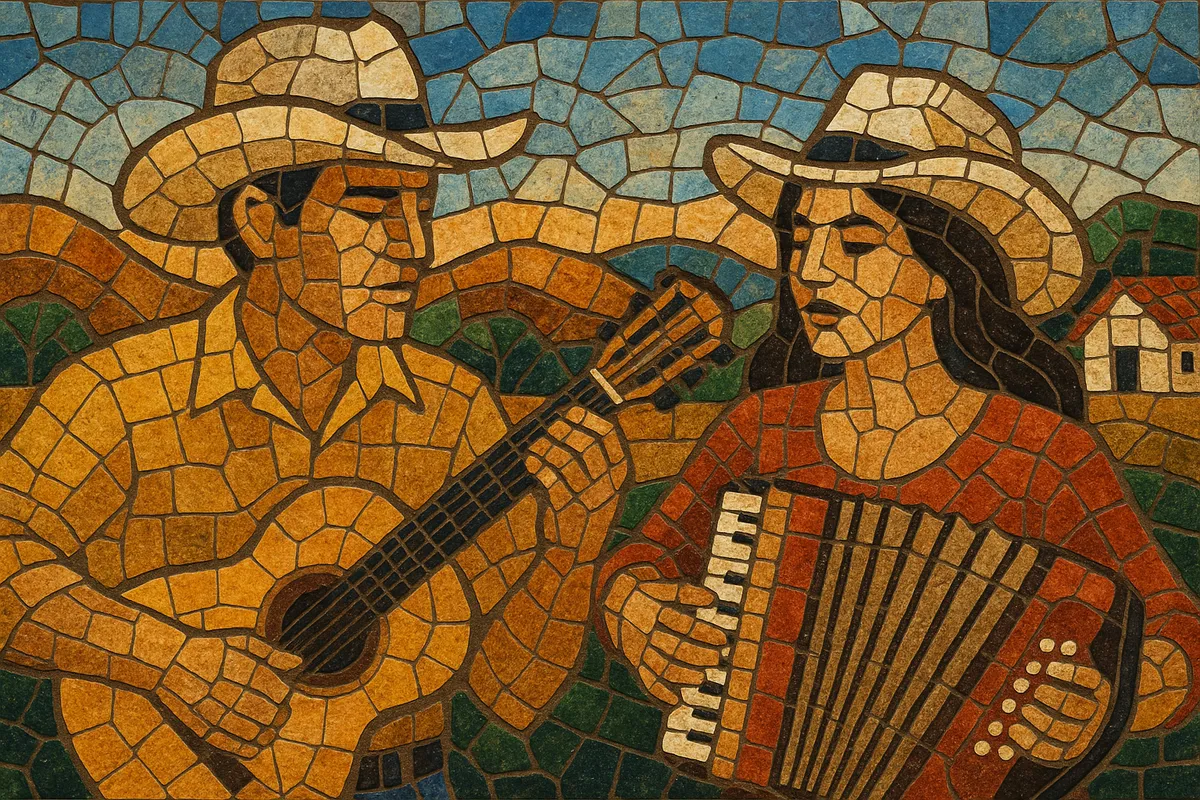Sertanejo is Brazil’s homegrown counterpart to country music, rooted in the rural song traditions of the country’s interior (música caipira) and later modernized for urban radio and arenas. Its core sound revolves around close-harmony duos, storytelling lyrics about love, longing, and countryside life, and the distinctive timbre of the viola caipira (10‑string Brazilian guitar) alongside acoustic guitar, accordion, and, in contemporary productions, full rhythm sections and pop‑leaning arrangements.
Across a century, sertanejo evolved through several waves: the narrative, acoustic sertanejo raiz; the polished, romantic duos that conquered national television and FM radio; and the 2000s/2010s universitário movement that fused pop, rock, and electronic textures. Today it is one of Brazil’s most commercially dominant genres, spawning numerous substyles and crossovers while retaining its identity of heartfelt vocal harmonies and sing‑along choruses.
Sertanejo grows out of música caipira and folk forms from Brazil’s interior. The first recordings linked to the style were catalyzed by folklorist‑producer Cornélio Pires at the end of the 1920s, bringing rural duos and the viola caipira to shellac discs and radio. Early repertoire featured narrative ballads (moda de viola), devotional pieces, and dance rhythms, reflecting everyday agrarian life.
With radio and TV expansion, vocal duos became the genre’s emblem. Artists professionalized arrangements, adding accordion, bass, and drums while keeping acoustic guitars and viola at the core. Influences from neighboring Paraguay and Argentina (polca paraguaya, chamamé) and from North American country subtly entered via instrumentation and song form.
The 1990s popularized a sleeker, romantic sound—big choruses, modulations, and power‑ballad aesthetics—without abandoning rural themes. Duos dominated charts and stadiums, aided by major labels, TV variety shows, and nationwide touring circuits. Production adopted soft rock textures, synthesizers, and tighter drum grooves.
University party circuits and social media propelled a new generation that fused pop, EDM touches, and R&B phrasing (sertanejo universitário). Simultaneously, feminejo foregrounded women’s perspectives on love and agency, reshaping lyrical narratives. Crossovers with funk brasileiro (funknejo) and other mainstream styles broadened the audience, cementing sertanejo as a centerpiece of Brazil’s live and streaming economy.
Start with a vocal duo as the focal point. Use viola caipira (10‑string) and acoustic guitar for the harmonic bed; add accordion for melodic fills. Modern productions commonly include electric bass, drums, and light keyboards or pads; occasional pedal steel or violin can add country or romantic color.
Common meters are 2/4 or 4/4 at moderate tempos for radio‑friendly tracks, and slow 6/8 for reflective ballads influenced by regional dances. Keep grooves steady and danceable, with acoustic strums outlining the backbeat and simple kick–snare patterns in contemporary arrangements.
Rely on diatonic progressions (I–V–vi–IV, I–IV–V, or ii–V–I in relative major/minor). Romantic choruses often lift with a late‑song modulation (e.g., up a whole step). Write singable melodies with parallel 3rds/6ths in the duo, alternating lead lines and tight harmonies.
Center lyrics on love, heartbreak, saudade, family, and rural imagery (roads, farms, festivities). Storytelling is key—use vivid details, plain language, and memorable hooks in the chorus. In contemporary tracks, blend traditional themes with modern urban references, keeping an emotive, conversational tone.
Use verse–pre–chorus–chorus forms with a short instrumental intro (viola/accordion motif). Add a concise bridge before the final chorus. Layer arrangement gradually: start intimate (voice + viola), then build with rhythm section and backing harmonies; consider a key change for the last chorus to maximize lift.
Keep vocals upfront with warm compression and gentle plate or room reverb. Double guitars for width; tuck accordion or fiddle fills between vocal phrases. For pop‑leaning tracks, subtle synth pads and tuned percussion can modernize the texture without overshadowing acoustic instruments.


